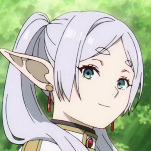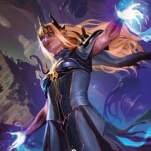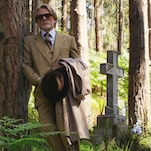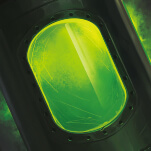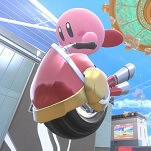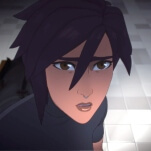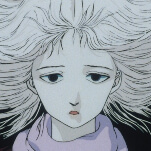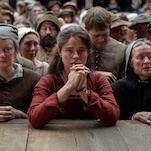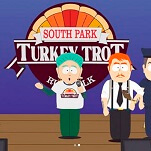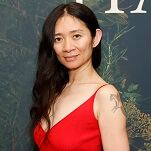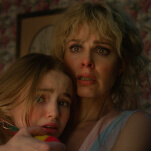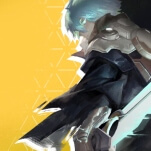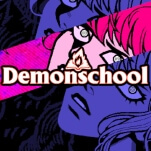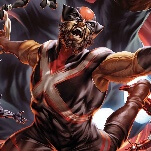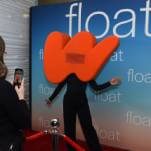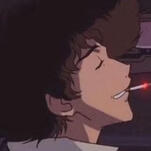Moomin and Squirrel Girl delight, Sam Zabel And The Magic Pen stimulates
Christmas gift-giving season is long over, but if you feel like buying yourself a present to bust those winter blues, Drawn & Quarterly has you covered. It has been publishing Tove Jansson’s Moomin strips since 2006. Although the Moomin novels and picture books were never unknown in the United States, they remained in circulation primarily as cult objects. Initially unsure whether the Finnish cartoonist’s work could find an audience in the English-speaking world, the books became the fastest sellers in the company’s history. The cult was, blessedly, larger than anticipated. It was even large enough to continue publishing Moomin books after Jansson’s original run, and into the period after her brother Lars had taken over the strip (the series is currently on volume 9). Moomin: The Deluxe Anniversary Edition (Drawn & Quarterly) features the entirety of Jansson’s run, from 1954-1959.
If you’ve never had the pleasure, the Moomin are chalk-white hippo creatures that live in Finland. There’s a familial resemblance to Al Capp’s Shmoos. Skeptical readers may be rolling their eyes already, but the Moomin are a breed apart from the anodyne children’s entertainment popular in the Anglo-American world. They aren’t always nice and they don’t solve their problems by hugging; they’re just as likely to celebrate never having to work again by getting drunk on berry wine. Young Moomintroll (or, “Moomin” for short) is naive and spirited, albeit often depressed. His parents, Moominpappa and Moominmanna are, respectably, distracted and unflappable. Moomintroll’s best friends are an itinerant wise man with a deep distrust of authority (the impish human Snufkin) and an immature rat-dog (Sniff). Moomintroll’s girlfriend is Snork Maiden, and Snorks are almost identical to Moomins, save for the fact that Snorks can change color.
What sets the Moomin stories apart is Jansson’s unique and endearingly tetchy perspective. Considering how big the Moomin stories were and remain in Europe and across the globe (Japan loves the Moomin, as you might expect), it is remarkable how distinct and personal Jansson’s vision remained throughout the series. The Moomin are by turns vain, skeptical, cynical, gullible, and just as likely to run afoul of the police as they are to adventure across the high seas. The stories themselves are odd and rickety contraptions, beginning at arbitrary points (one sequence begins with Moomintroll sniffing around in the bushes for something with which to start the story), careening from one plot to another until the original conflict and the characters themselves are thoroughly exhausted. Fans of Floyd Gottfredson’s early, freewheeling Mickey Mouse strips will find something similar here.
The Deluxe Anniversary Edition is a formidable volume, a full 448 pages of daily comic strips accompanied by a few pages of sketches and essays. Despite its size it fits neatly in two hands spread across your lap, or you can lay it flat on a table, enabling you to read the book with a friend, perhaps a young one sitting on your lap and pointing at all the funny pictures. That said, these are not strictly children’s strips. There are too many sharp edges and eccentricities for anyone, especially a child, to appreciate immediately. The Moomin world is worthy of many visits. [TO]
As DC converges and Marvel prepares for a Secret War, Valiant Comics is becoming a more attractive third option for readers who want strong superhero titles without the baggage of Big Two comics. Valiant is still in the early stages, building a stable of characters while DC and Marvel are trying to figure out how to negotiate all the different versions of the heroes they’ve introduced over the years. Everything is more contained and accessible at Valiant, largely because it has limited its output to no more than nine titles a month, rotating different characters into the spotlight to see which ones resonate strongest with readers.
The Valiant Next publishing initiative will see six new titles launch by April, and Ivar, Timewalker #1 (Valiant) is the first ongoing series of the bunch, reuniting the Archer & Armstrong team of writer Fred Van Lente and artist Clayton Henry for a sci-fi action adventure starring a time-jumping immortal and a young female physicist. There’s definitely some Doctor Who in the book’s DNA, but as books like Marvel’s Silver Surfer have proven, the Doctor Who formula is a great foundation, because it offers limitless storytelling possibilities while grounding fantastic events in a core relationship between one central figure and a companion.
This first issue brings the two characters together with an extended action sequence that highlights the thrill of time travel. Ambushed by mysterious agents at Switzerland’s CERN, Ivar grabs Dr. Neela Sethi out of the present and takes her to 1805’s Battle Of Trafalgar for some maritime action before settling into the 41st Century to deliver some valuable exposition. The story’s rapid pace heightens Neela’s disorientation and confusion as she’s dragged along on an adventure she didn’t ask for, but by the end of the issue, Van Lente makes it very clear why Neela’s an essential part of the narrative with a cliffhanger that introduces many paradoxical questions.
Henry’s smooth, crisply detailed artwork transitions between quiet character moments, tense drama, and spectacular action with ease, realizing Van Lente’s script with clean, multifaceted visuals. His layouts in this issue are more imaginative than his usual work, particularly a two-page spread that layers two-dimensional panels in a three-dimensional space to show Ivar and Neela moving through different planes of time. Brian Reber’s coloring distinguishes these time periods by applying different shades to each panel, alternating between, warm, cold, and neutral tones with each jump. But the most important thing about the artwork for this first issue is Raul Allen’s cover, which captures the book’s concept in one arresting graphic visual. Valiant is putting more emphasis on creating attention-grabbing covers for its Valiant Next books, and this focus on bold design will help these titles stand out from other superhero fare even more. [OS]
It’s been almost two decades since Dylan Horrocks’ Hicksville established him as a major new voice in comics, a creative and professional breakthrough that was followed by assorted smaller pieces and a few projects for DC Comics and Vertigo, but nothing that could be considered a true follow-up to his seminal work. That finally changes with the release of Sam Zabel And The Magic Pen (Fantagraphics), a full-color graphic novel detailing the artistic crisis of a cartoonist struggling to make something meaningful as he does freelance work for a superhero comics publisher.







